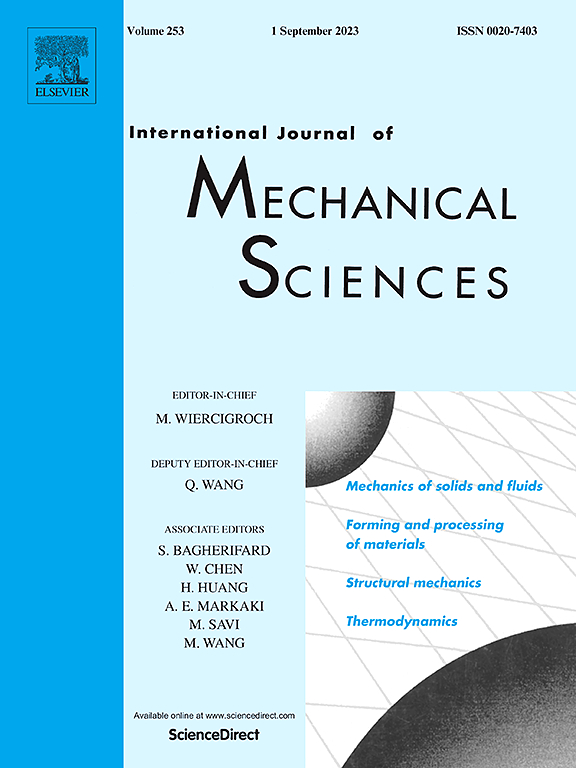低频瑞利波衰减的耗散局部共振超表面
IF 7.1
1区 工程技术
Q1 ENGINEERING, MECHANICAL
International Journal of Mechanical Sciences
Pub Date : 2025-04-19
DOI:10.1016/j.ijmecsci.2025.110233
引用次数: 0
摘要
来自地震和交通的低频瑞利波对工程结构构成重大风险,但其宽带缓解仍然是一项挑战。为了解决这个问题,我们开发了一种弹性耗散超表面(EDM),它利用多共振和工程阻尼来实现宽带瑞利波抑制。利用有效的理论,我们建立了一个描述电火花加工波动行为的框架,该框架与数值模拟密切匹配,为设计先进的超表面提供了一种有效的方法。我们的分析表明,阻尼可以打破传统的限制,要求瑞利波色散曲线停留在声锥之外,允许它们进入声锥。为了量化能量传递过程,我们引入了基于Poynting定理的机械能通量分析,揭示了耗散系统中瑞利波的散射和向其他波模式的转换。此外,我们提出了一种绝热电火花加工设计,结合慢速空间调制来消除反射并实现完美的彩虹吸收。这种方法保证了无缝的能量耗散,同时克服了传统超表面的窄带限制和不完美的吸收。数值模拟证实了电火花加工的优越性能,展示了宽带波抑制、增强吸收和可控的能量转换。我们的研究结果通过工程耗散和分级微结构为瑞利波控制提供了新的见解,为下一代功能超表面在隔震、结构保护和振动控制方面的应用铺平了道路。本文章由计算机程序翻译,如有差异,请以英文原文为准。

Dissipative locally resonant metasurfaces for low-frequency Rayleigh wave mitigation
Low-frequency Rayleigh waves from earthquakes and traffic pose significant risks to engineering structures, yet their broadband mitigation remains a challenge. To address this, we develop an elastic dissipative metasurface (EDM) that leverages multi-resonance and engineered damping to achieve broadband Rayleigh wave suppression. Using effective theory, we establish a framework for describing the wave behavior of EDMs, which closely matches numerical simulations and provides an efficient approach to designing advanced metasurfaces. Our analysis reveals that damping can break the traditional constraint requiring Rayleigh wave dispersion curves to stay outside of the sound cone, allowing them to enter the sound cone. To quantify energy transfer processes, we introduce a mechanical energy flux analysis based on Poynting’s theorem, revealing the scattering and conversion of Rayleigh waves into other wave modes in dissipative systems. Furthermore, we propose an adiabatic EDM design, incorporating slow spatial modulation to eliminate reflections and achieve perfect rainbow absorption. This approach ensures seamless energy dissipation while overcoming the narrowband limitations and imperfect absorption of conventional metasurfaces. Numerical simulations confirm the superior performance of EDMs, demonstrating broadband wave mitigation, enhanced absorption, and controlled energy conversion. Our findings provide new insights into Rayleigh wave manipulation through engineered dissipation and graded microstructures, paving the way for next-generation functional metasurfaces with applications in seismic isolation, structural protection, and vibration control.
求助全文
通过发布文献求助,成功后即可免费获取论文全文。
去求助
来源期刊

International Journal of Mechanical Sciences
工程技术-工程:机械
CiteScore
12.80
自引率
17.80%
发文量
769
审稿时长
19 days
期刊介绍:
The International Journal of Mechanical Sciences (IJMS) serves as a global platform for the publication and dissemination of original research that contributes to a deeper scientific understanding of the fundamental disciplines within mechanical, civil, and material engineering.
The primary focus of IJMS is to showcase innovative and ground-breaking work that utilizes analytical and computational modeling techniques, such as Finite Element Method (FEM), Boundary Element Method (BEM), and mesh-free methods, among others. These modeling methods are applied to diverse fields including rigid-body mechanics (e.g., dynamics, vibration, stability), structural mechanics, metal forming, advanced materials (e.g., metals, composites, cellular, smart) behavior and applications, impact mechanics, strain localization, and other nonlinear effects (e.g., large deflections, plasticity, fracture).
Additionally, IJMS covers the realms of fluid mechanics (both external and internal flows), tribology, thermodynamics, and materials processing. These subjects collectively form the core of the journal's content.
In summary, IJMS provides a prestigious platform for researchers to present their original contributions, shedding light on analytical and computational modeling methods in various areas of mechanical engineering, as well as exploring the behavior and application of advanced materials, fluid mechanics, thermodynamics, and materials processing.
 求助内容:
求助内容: 应助结果提醒方式:
应助结果提醒方式:


